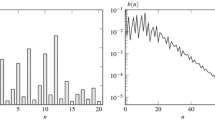Abstract
In this paper, we investigate a single-server discrete-time queueing system subject to two independent batch Bernoulli arrival processes, each supplying the queue with different customer classes. The two classes of customers have different priority levels in the queue, and different service-time distributions. The studied priority mechanism is time-limited, i.e., customers of the high-priority class cannot overtake customers of lower priority if the latter arrived at least N slots earlier than the former. The parameter N makes the mechanism versatile, spanning a bridge between absolute (fixed) priority and slot-bound priority (see De Clercq et al. in Math Probl Eng. doi:10.1155/2012/425630, 2012). The time-limited overtake priority mechanism maintains levels of fairness that are unattainable by a pure absolute priority mechanism, and offers more service differentiation than the slot-bound priority alternative studied earlier. By using a censoring argument, we obtain expressions for the steady-state probability generating functions of the delays of both customer classes, as well as the steady-state joint probability generating function of the system content, by using a censoring argument.






Similar content being viewed by others
References
Abramowitz, M., & Stegun, I. A. (1972). Handbook of mathematical functions with formulas, graphs, and mathematical tables. Dover Publications, New York. ISBN 978-0-486-61272-0.
Bae, J. J., & Suda, T. (1991). Survey of traffic control schemes and protocols in ATM networks. Proceedings of the IEEE, 79(2), 170–184.
Bini, D. A., Latouche, G., & Meini, B. (2005). Numerical methods for structured Markov chains. Numerical Mathematics and Scientific Computation, Oxford Science Publications. New York: Oxford University Press.
Bruneel, H., Fiems, D., Walraevens, J., & Wittevrongel, S. (2014). Rejoinder on: Queueing models for the analysis of communication systems. TOP, 22(2), 460–468.
Burnetas, A. N., & Katehakis, M. N. (1993). On sequencing two types of tasks on a single processor under incomplete information. Probability in the Engineering and Informational Sciences, 7(1), 85–119.
Cooley, J. W., & Tukey, J. W. (1965). An algorithm for the machine calculation of complex Fourier series. Mathematics of Computation, 19(90), 297–301.
De Clercq, S., Steyaert, B., & Bruneel, H. (2012a). Queue content analysis in a 2-class discrete-time queueing system under the slot-bound priority service rule. Mathematical Problems in Engineering. doi:10.1155/2012/425630.
De Clercq, S., Laevens, K., Steyaert, B., & Bruneel, H. (2013). A multi-class discrete-time queueing system under the FCFS service discipline. Annals of Operations Research, 202(1), 59–73.
De Clercq, S., Steyaert, B., & Bruneel, H. (2012b). Delay analysis of a discrete-time multiclass slot-bound priority system. 4OR A Quarterly Journal of Operations Research, 10(1), 67–79.
De Vuyst, S., Wittevrongel, S., & Bruneel, H. (2008). Place reservation: Delay analysis of a novel scheduling mechanism. Computers and Operations Research, 35(8), 2447–2462.
Feng, J., & Xu, L. (2012). Throughput-smoothness tradeoff in preventing competing TCP from starvation. Computer Communications, 35(6), 696–708.
Fiems, D., Walraevens, J., & Bruneel, H. (2007). Performance of a partially shared priority buffer with correlated arrivals, In Proceedings of the 20th international Teletraffic Congress (ITC20), Ottawa, Lecture Notes in Computer Science (Vol. 4516, pp. 582–593).
Floyd, S., & Jacobson, V. (1993). Random early detection gateways for congestion avoidance. IEEE-ACM Transactions on Networking, 1(4), 397–413.
Goldberg, H. M. (1977). Analysis of the earliest due date scheduling rule in queueing systems. Mathematics of Operations Research, 2(2), 145–154.
Jackson, J. R. (1955). Scheduling a production line to minimize maximum tardiness. California Univ Los Angeles Numerical Analysis Research.
Janiak, A., Janiak, W. A., Krysiak, T., & Kwiatkowski, T. (2015). A survey on scheduling problems with due windows. European Journal of Operational Research, 242(2), 347–357.
Latouche, G., & Ramaswami, V. (1999). Introduction to matrix analytic methods in stochastic modeling ASA-SIAM Series on Statistics and Applied Probability. Philadelphia, PA: Society for Industrial and Applied Mathematics (SIAM).
Liang, S. T., & Yuang, M. C. (1998). Realization of earliest-due-date scheduling discipline for ATM switches. IEICE Transactions on Communications, 81B(2), 363–372.
Lim, Y. H., & Kobza, J. E. (1990). Analysis of a delay-dependent priority discipline in an integrated multiclass traffic packet switch. IEEE Transactions on Communications, 38(5), 659–665.
Maertens, T., Walraevens, J., & Bruneel, H. (2008). Performance comparison of several priority schemes with priority jumps. Annals of Operations Research, 162(1), 109–125.
Meisling, T. (1958). Discrete-time queuing theory. Operations Research, 6(1), 96–105.
Tatashev, A. G. (1984). Calculation of the distribution of the waiting time in a multiple-channel queuing system with fixed priorities. Engineering Cybernetics, 22(1), 59–62.
Van Mieghem, P., Steyaert, B., & Petit, G. H. (1997). Performance of cell loss priority management schemes in a single server queue. International Journal of Communication Systems, 10(4), 161–180.
Walraevens, J., Steyaert, B., & Bruneel, H. (2000). Performance analysis of the system contents in a discrete-time non-preemptive priority queue with general service times. Belgian Journal of Operations Research Statistics and Computer Science (JORBEL), 40, 91–103.
Wilf, H. S. (1994). Generatingfunctionology. Department of Mathematics, University of Pennsylvania, Academic Press Inc., ISBN 0-12-751956-4.
Zhao, Y. Q., & Liu, D. (1996). The censored Markov chain and the best augmentation. Journal of Applied Probability, 623–629.
Acknowledgments
This research has been partly funded by the Interuniversity Attraction Poles Programme initiated by the Belgian Science Policy Office.
Author information
Authors and Affiliations
Corresponding author
Rights and permissions
About this article
Cite this article
De Clercq, S., Steyaert, B., Wittevrongel, S. et al. Analysis of a discrete-time queue with time-limited overtake priority. Ann Oper Res 238, 69–97 (2016). https://doi.org/10.1007/s10479-015-2000-8
Published:
Issue Date:
DOI: https://doi.org/10.1007/s10479-015-2000-8




